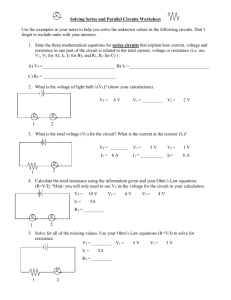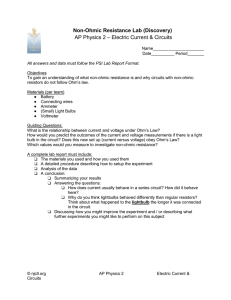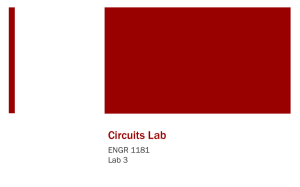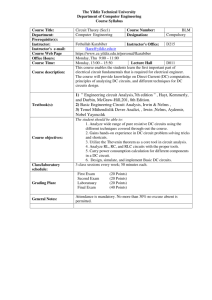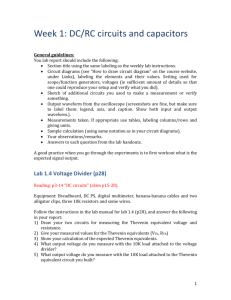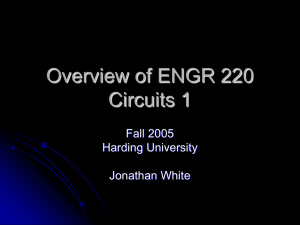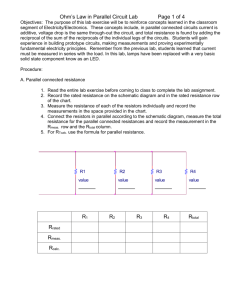ELC 106 Circuit Analysis I and Basic Electrical Measurements
advertisement
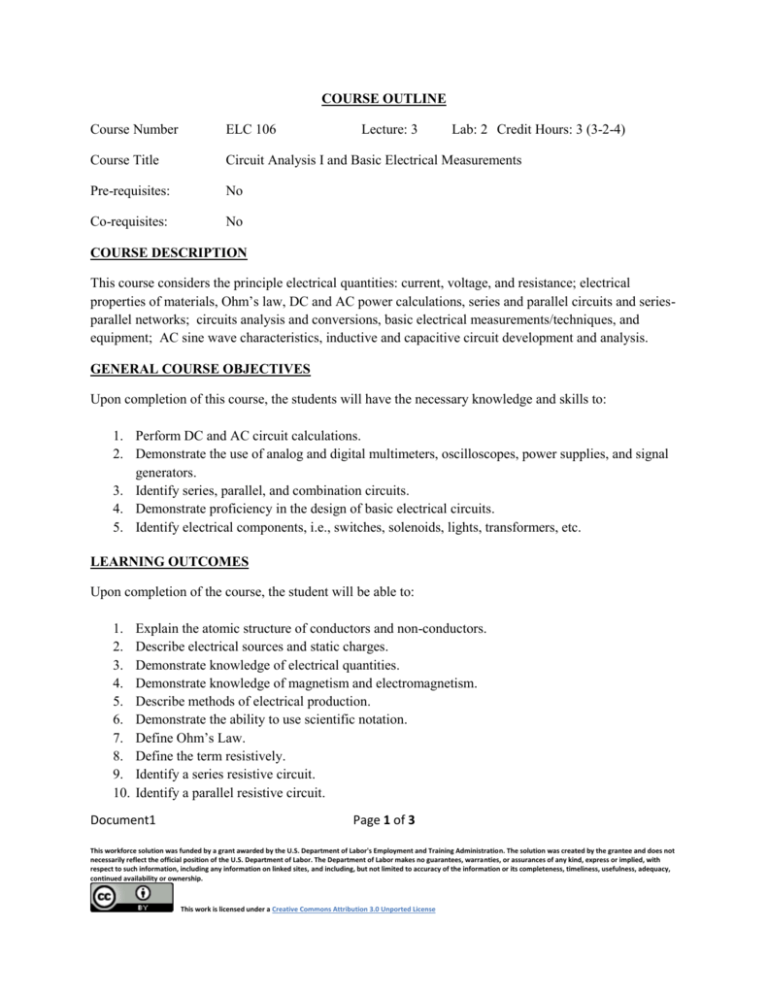
COURSE OUTLINE Course Number ELC 106 Lecture: 3 Lab: 2 Credit Hours: 3 (3-2-4) Course Title Circuit Analysis I and Basic Electrical Measurements Pre-requisites: No Co-requisites: No COURSE DESCRIPTION This course considers the principle electrical quantities: current, voltage, and resistance; electrical properties of materials, Ohm’s law, DC and AC power calculations, series and parallel circuits and seriesparallel networks; circuits analysis and conversions, basic electrical measurements/techniques, and equipment; AC sine wave characteristics, inductive and capacitive circuit development and analysis. GENERAL COURSE OBJECTIVES Upon completion of this course, the students will have the necessary knowledge and skills to: 1. Perform DC and AC circuit calculations. 2. Demonstrate the use of analog and digital multimeters, oscilloscopes, power supplies, and signal generators. 3. Identify series, parallel, and combination circuits. 4. Demonstrate proficiency in the design of basic electrical circuits. 5. Identify electrical components, i.e., switches, solenoids, lights, transformers, etc. LEARNING OUTCOMES Upon completion of the course, the student will be able to: 1. 2. 3. 4. 5. 6. 7. 8. 9. 10. Explain the atomic structure of conductors and non-conductors. Describe electrical sources and static charges. Demonstrate knowledge of electrical quantities. Demonstrate knowledge of magnetism and electromagnetism. Describe methods of electrical production. Demonstrate the ability to use scientific notation. Define Ohm’s Law. Define the term resistively. Identify a series resistive circuit. Identify a parallel resistive circuit. Document1 Page 1 of 3 This workforce solution was funded by a grant awarded by the U.S. Department of Labor's Employment and Training Administration. The solution was created by the grantee and does not necessarily reflect the official position of the U.S. Department of Labor. The Department of Labor makes no guarantees, warranties, or assurances of any kind, express or implied, with respect to such information, including any information on linked sites, and including, but not limited to accuracy of the information or its completeness, timeliness, usefulness, adequacy, continued availability or ownership. This work is licensed under a Creative Commons Attribution 3.0 Unported License 11. 12. 13. 14. 15. 16. 17. 18. 19. 20. 21. 22. 23. 24. Identify a combination resistive circuit. Define the basic principles of Direct Current. Define the basic principles of Alternating Current. Describe the characteristics of AC with regards to resistance, inductance, and capacitance. Define Alternating Current power and power factor. Demonstrate the ability to calculate voltage, current, and resistance. Demonstrate the ability to use various other electrical formulae. Define Kirchoff’s voltage and current laws. Demonstrate knowledge of voltage and current dividers. Describe a Wheatstone Bridge. Perform capacitive and inductive circuit calculations. Demonstrate knowledge of transformer operation ad use. Demonstrate familiarity with electrical safety procedures. Perform voltage, current, and resistance measurements with various types of analog and digital equipment. 25. Demonstrate knowledge and use of power supplies, function generators, and oscilloscopes. TEXT Principles of Electric Circuits, Floyd, 9th Edition TOPICAL COURSE OUTLINE Week Week 1 Week 2 Week 3 Week 4 Week 5 Week 6 Week 7 Week 8 Week 9 Week 10 Week 11 Week 12 Document1 Topic Course Introduction – Quantities and Units DC Voltage, DC Current, Resistance Ohm’s Law Energy and Power Test 1 and Lab Quiz 1 Series Circuits Parallel Circuits Series/Parallel Combination Circuits Test 2 and Lab Quiz 2 Magnetism and Electromagnetism Introduction to AC Current and Voltage Test 3 and Lab Quiz 3, Introduction to Capacitors Page 2 of 3 This workforce solution was funded by a grant awarded by the U.S. Department of Labor's Employment and Training Administration. The solution was created by the grantee and does not necessarily reflect the official position of the U.S. Department of Labor. The Department of Labor makes no guarantees, warranties, or assurances of any kind, express or implied, with respect to such information, including any information on linked sites, and including, but not limited to accuracy of the information or its completeness, timeliness, usefulness, adequacy, continued availability or ownership. This work is licensed under a Creative Commons Attribution 3.0 Unported License Week 13 Week 14 Week 15 Finals Week Introduction to Inductors Introduction to Transformers Course Lecture and Lab Review Final Examination The schedule is subject to change at the discretion of the instructor. Reviewed and Approved by: ______________________________________________ Division Dean Document1 Date Page 3 of 3 This workforce solution was funded by a grant awarded by the U.S. Department of Labor's Employment and Training Administration. The solution was created by the grantee and does not necessarily reflect the official position of the U.S. Department of Labor. The Department of Labor makes no guarantees, warranties, or assurances of any kind, express or implied, with respect to such information, including any information on linked sites, and including, but not limited to accuracy of the information or its completeness, timeliness, usefulness, adequacy, continued availability or ownership. This work is licensed under a Creative Commons Attribution 3.0 Unported License

